PFA All-Star Teacher Showcase
Steve Cox - 1999 PFA All-Star Teacher of the Year
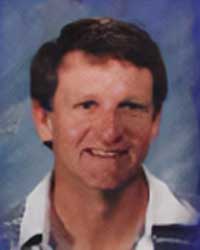 Steve has taught physical education at Watrous Elementary School in Des Moines, Iowa for 30 years. He received a PFA grant in 1995 and has created a host of new games and activities that have been tested tried and true. His lesson plans are easy to implement, offer a variety of activities from ten minutes to forty-five minutes in length. Most notable is that these activities excite the students, challenge them and make fitness fun!
Steve Cox is a teacher of teachers. PFA was founded on the steadfast belief that if we give the best tools to teachers, they will create their best work. The work of Steve Cox is a testimony to this belief and our mission. Steve is the perfect selection to serve as our first official All-Star Teacher of the Year 1999.
Congratulations Steve! As we begin 2000 we thank you for your leadership, dedication, and care for the health and wellness of our nation’s youth.
Steve has taught physical education at Watrous Elementary School in Des Moines, Iowa for 30 years. He received a PFA grant in 1995 and has created a host of new games and activities that have been tested tried and true. His lesson plans are easy to implement, offer a variety of activities from ten minutes to forty-five minutes in length. Most notable is that these activities excite the students, challenge them and make fitness fun!
Steve Cox is a teacher of teachers. PFA was founded on the steadfast belief that if we give the best tools to teachers, they will create their best work. The work of Steve Cox is a testimony to this belief and our mission. Steve is the perfect selection to serve as our first official All-Star Teacher of the Year 1999.
Congratulations Steve! As we begin 2000 we thank you for your leadership, dedication, and care for the health and wellness of our nation’s youth. Steve Cox Lesson Plans
Copy and Pass
(Simple Activity for good introduction to the PFA stations)
Length of activity: 10 minutes
Optimal Student Grade Level: K-2.
Steve’s Notes: This is a continuous motion lesson, great warm-up for K-2, but older grades like it too. When you see your fastest kids passing 2-3 times, you know the other kids are getting tired and it is time to conclude the game.
How to Play:
The leader goes around the station area in a special physical movement way
Example: Slow motion jog, twist walk, side-ways walk, tip toe walk, crawl, athletic shuffle, bunny hop, skip, back walk, etc.
The teacher yells “Pass”… all behind may jog or run, passing the leader (leader keeps going the same way – the same pace)
As others pass the leader they will yell “Pass 1” the first time they pass…
“Pass 2” second time they pass etc.
The teacher finally yells “Halt!” and then takes the class to a PFA station and then;
- Teaches Safety Lesson (kids who passed leader the most can be the 1st demos)
- Teach a proper procedure lesson
- Teach a Hint/Helper for that station
Lions, Tigers & Bears
Length of Activity: 20-30 minutes
Optimal Student Grade Level: K-2
Steve’s Notes: This game is a great way to introduce the use of the PFA equipment properly and safely. This game can get very tiring. You can introduce terms, “Heart/Lung Workout” or “Cardio Workout” & “Continuous Movement”
How to Play:
Divide the class into 3 teams -Lions, Tigers & Bears-
The teams do work tasks to earn three cups. The team that earns the most cups, wins.
Tasks
- Kick a ball to a certain spot and back
- Jog to certain spot and back
- Do a PFA station “Round the World Touch” this is when the students go to PFA stations and touch each station and yell its name as you touch it.
- Do a different task each time.
After finishing any task, the students go and get three cups and add them to their teams’ giant circle… then they may go and do another task. If it is windy, give each team 3 thin-topped pylons & they may stack their cups on the pylons.
Equipment
Several hundred cups…. Pylons and kickballs
Helpful Hints
- Have four or five 5th graders (if you can get them out of class) assist/help with this lesson.
- One older kid works/trouble-shoots with the lions, one with the tigers, one with the bears
- Have older kids stay at stations to encourage and help tell them names of stations
- The teacher oversees all activities.
Ornery Rabbits & Sleepy Bears
Length of Activity: Anywhere from 20 to 30 minutes
Optimal Student Grade Level: Great for Kindergarten to Third grade. You may even want to try this with your older students – they all love it.
Equipment:
- 3 short pylons that will hold a ball (tops cut off around the size of a tennis ball)
- Cute jersey or top for “bears” to wear (fake fur is fun!)
- 3 soft, spongy throwing balls (around the size of a volleyball)
- 2 or more pylons for “Ornery Rabbit Safe Zone Line”
Steve’s Notes: Wonderful way to introduce the children to the equipment. If you start off with Copy and Pass, and then go onto Lions, Tigers & Bears, and then use this lesson plan, the younger students will gradually become familiar with the equipment and with this game, they will be using the stations on their own for the first time. This game must be played close to the PFA station equipment.
How to Play: Pick three students to be sleepy bears, have them put on their tops, and stand over the throwing balls with their backs to the ornery rabbits (remainder of the class). The Ornery rabbits stand by the safe zone line (about 30 feet away (more for bigger kids) from the bears) and on teacher command, “Slow Tip Toe” … the rabbits tiptoe slowly up behind the sleepy bears (can’t go in front, can’t touch a bear) … and they start whispering to the bears “Wake up sleepy bear… Winter’s over sleepy bear…You smell funny sleepy bear.” The teacher then yells, “WAKE UP!” The bears pick up the throwing balls, turn and throw them at fleeing rabbits who are running toward their “Safe Zone Line”. Rabbits who are hit before they make it to the safe zone line & rabbits who fall down become “Injured Rabbits” and they have to go to the “PFA Hospital” to recover. That is one round and the bears should be changed every 3 to 4 rounds. PFA Hospital Injured rabbits must limp (the kids really love to act this out and the others like to watch) to the PFA Hospital (equipment stations) to get healthy and well. They are healed when they have completed the appropriate number of repetitions. You can increase the number of reps and the difficulty for the older students.
- 10 sit-ups
- 1 horizontal ladder
- 20 steps (up up/down down)
- 15 modified pull ups
HINTS
- Don’t let rabbits run to the bears
- Don’t let rabbits talk too loud to the bears
- When you have hyper or dangerous rabbits – have them do a “Walk & Think Safety lap”
- Add Bears & Balls if you want more injured rabbits
- GREAT reward game after they learn it!
Tennis Ball P.F.A. warm up
Length of Activity: 10-20 minutes
Optimal Student Grade Level: 2-6
Steve’s Notes: Set the number of reps on each station that it takes to get a tennis ball. Example words to spell out: Reps, Pace, Kick, NCAA, coed, etc.
Equipment:
Have a couple 100 tennis balls / buckets and a few jump ropes.
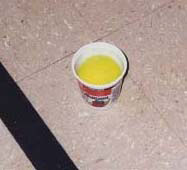
Rep – Goals
- Parallel Bar – 1 = one ball
- Full Pull Up – 1 = one ball
- Mod Pull Up – 1 = one ball
- Sit ups – 10 = one ball
- Steps – 30 = one ball
- V-Bar – 3 = one ball
- Pole Climb = red = two balls (w/ safe dismount)
- Pole Climb = yellow = one ball
- Horizontal Ladder – down & up with one ground touch = one ball
- 1/4 mile jog = three balls
- 1/8 mile jog = 2 balls
- Rope jump – 50 (by yourself) = two balls
The teacher chooses the word to be spelled.
Once a child completes the “rep goal” on any station, they run and get a tennis ball and take it to the “spell area” and put it where they think it will help spell the word.
Once the word is spelled to the point that it is readable, have the class do a brief (small or large group) discussion on the Physical Educational meaning of the word.
Once that is done, go on to another activity.
Hit and Run
Length of Activity: 40 minutes
Optimal Student Grade Level: 2-6 This could do a scaled-down, simple version for K-1 (30 minutes).
Steve’s Notes: This is a high-level fitness workout. This lesson takes a lot of preparation but is a great total class activity and worth the effort. Create a reward or special recognition for kids or class with the most “completion bracelets.” You can do this lesson as a class (everyone on their own) or in “team groups.”
How to Play
Hit
Each hit is any of the many pre-determined fitness stations (see below for examples). Flags/markers with reps. & directions are beneficial. Have the students do the station expectation to the best of their ability.
Run
After completing any station (making a hit) the student then must go and do a 1/4 or 1/8 mile jog.
Teacher Measurement – Have completion bracelets or large rubber bands to give any kid when they complete a run.
1/8 mile = 1 rubber band
1/4 mile = 3 rubber bands
After a run, they go do another “hit”
Hit Stations – be as creative as you wish
They may only do one particular “hit station” once (creating variety and experimentation).
Example Hit stations:
- All P.F.A. Stations – set the reps in a “middle-ground range” not too easy, not too hard!
- Basketball Shoot – 15 baskets
- Rope Jump (Individual) – 120
- Long Rope Jump (Group of three) – 2 swingers and a jumper…switch any time – 100 jumps (may add together)
- Jungle Gym = some set challenge
- Fireman’s Carry Jog – pick up a rescue dummy and carry it over your shoulder while you jog 1/8 of a mile. (Dummy = double pillowcase filled with tennis balls … sew on funny face & old jean legs & socks, you might want 2 of these.)
- Medicine Ball Toss – create a group of 3 people … alternate your tosses and walk/jog down a set course and back. (Medicine ball = old basketball filled with sand and then placed inside another old basketball then duct or athletic tape it.) Underhand tosses are safer.
- Soccer Dribble Obstacle Course – Set out pylons and have a student soccer dribble (kick) a ball down and back through the course weaving it in and out.
- Old Portable Ergonometer – Set the standard
- Old Rowing Machine – Set a standard
- Mini Trampoline – Bounce & catch/pass ball off the wall to yourself, while you are bouncing – Set reps and clearly discuss safety concerns with this one.
- Create others based on your equipment.
Three Cups and a Bone
Length of Activity: 35-40 minutes
Optimal Student Grade Level: 3-6
Steve’s Notes: This can be an outdoor and indoor activity. Both versions are described below. This game is excellent for teaching the philosophy of teamwork, communication, and cooperation (TCC). • I ordered the bones through U.S. Games — they’re called “Poly Parts” in the Catalog & cost around $40.
Outdoor Game:
Workers may do any of these work tasks to earn three cups and bone:
- 60 Rope Jumps — team jump… three children — two swingers and one jumper. Any combination of the three finally reach 60 jumps and all three get to gather three cups and bone.
- 10 baskets — shoot till you make ten baskets
- 1/4 mile jog
- 30-50 P.F.A. steps — up/up — down/down
- 30-50 P.F. A. Modified Pull-Ups
- 2 P.F.A. Regular Pull-Ups
- 1 P.F.A. Red Pole Climb
- 1 down and up P.F.A. Horizontal Ladder
- 30-50 P.F.A. sit-ups
Students let the teacher know when they have successfully completed a “work task” then take three cups and a bone to the builders. Put cups and bone where you think they belong. (Builders may move them) When you’re done go do a different work task.
Builders — build the best skeleton you can and create the roundest circle of cups you can create. Emphasize to students the importance of using TCC. If it is windy stack the cups on thin-topped pylons. Give each group 3 of these thin pylons.
Equipment – Hundreds of cups, two or more sets of Rubber Skeleton, six pylons, six basketballs, and two long jump ropes (Thin pylons for cups to stack on when it is windy).
Players — A team for every set of bones. Teams will be broken into builders and workers. Generally three builders and the rest workers.
Builders — They put together the skeleton and finalize the placement of cups for the giant circle. Important for them to fuse good T.C.C. They make final placement decisions. Workers bring them the bones.
Workers — They do the work tasks that earn the right to gather “Three cups and a bone”
Procedure — Teacher goes over general builder, worker, team jobs, and procedure
Teams — use T.C.C. in beginning… discuss strategy, problems … pick builders.
Workers — do the work tasks that earn the cups and bones
Indoor Game
Builders job — same as “Outdoor Game” only build a pyramid instead of a giant circle with the cup
Workers Tasks
- 10 baskets = 3 cups and bones
- Lone jump ropes = 3 kids (same as outdoor)
- Partner Sit Ups — in a group of three kids working together come up with 60 legal sit-ups. One kid does bent knee shoulder “X” sit-ups. One kid holds feet and one kid cushions the head. Switch at any time and get to 60.
- Group Circle Toss — any group of five or more children that can do three clean circle tosses in a row. That group gets ten cups and two bones.
Workers and Builders may trade with T.C.C. negotiation and teacher permission.
For Three cups and a bone, yogurt cups are
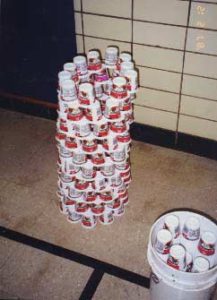
- Much easier to collect
- Easier to store
- Lend themselves also to a great catch/balance lesson with “Tennis Balls lesson plan.
- Easy to get through most school cafeterias — check with your area hospital.
 32-oz cups are a little more exciting but are very difficult to store as you need about 1000 to play the game.
32-oz cups are a little more exciting but are very difficult to store as you need about 1000 to play the game.
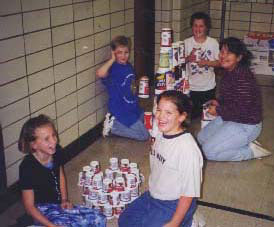 Kindergarten balancing cups after a workout.
Kindergarten balancing cups after a workout.
Pictured is 3 cups and a bone in action, using both yogurt and 32-oz cups. Please note the cardboard boxes in the background — these are homemade “steps for step aerobics. They have six cans in each.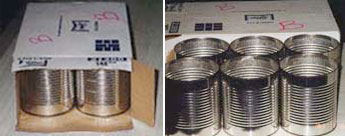
Cheap, good steps for Step Aerobics, or general workout activities. Your lunchroom can easily get you the cans and boxes.
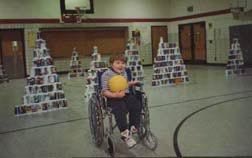 Special Ed Participation
Special Ed Participation
Often I let the Special Ed kids knock down the cups at the end, they love it! Most can easily participate at some adapted level.
Capture the Pins
Length of Activity: Minimum of 30 to 40 minutes
Optimal Student Grade Level: This has to be done in 3rd grade and up.
Steve’s Notes: Children beg to play this once they learn it. This is a definite reward game for the students. This is an excellent continuous movement and great cardiovascular workout. You must have a large play area such as a soccer or baseball field to do this game.
How to Play
Teams: 2 equal teams, each team has 1/2 of a large rectangular playing field
Equipment: jerseys, flag belts, 8 plastic bowling pins, many large pylons to create a field (very important to have a clear MID-LINE & sidelines), small cones/markers to make a “free-throw” circle size holding zone at the ends of the field.

Procedure:
- Opponents may capture your flag only when you are on their side.
- Cannot tackle dive, grab person or clothes
- Cannot protect flag by holding, or slapping hand or diving
- Flags get captured – you must go to “the holding zone” – they must hand you back your flag
To get out of “the holding zone”:
- Team Rescue – teammate get through to you – grabs your hand … may walk you back safely as long and you hold hands HIGH
- Captured Pin – teammate captures a pin and gets back to their side with it (show the teacher your pin and you then get to pick one teammate who gets safely out of “the holding zone” (walk back with your fist held HIGH) (toss pin safely in your backfield)
- Fitness workout – yell to the teacher that you’re going to go run a freedom 1/4 mile lap. Yell to the teacher you’re going to go do 60 PFA steps – or some variation with PFA equipment
Pin Guarding:
You must stand back one big step away from any pin you are guarding
Strategy:
There are many wise things and plays you can do as a team to help play better and win. Talk, plan, think, sacrifice.
Winning:
When all the players on one team are in “the holding zone”.
When you have captured all of your opponents’ pins
SAFETY
![]() Don’t grab or tackle runners
Don’t grab or tackle runners
![]() Don’t run forward while looking back (This is “running blind”… it’s dumb and dangerous)
Don’t run forward while looking back (This is “running blind”… it’s dumb and dangerous)
![]() No diving or jumping or twisting
No diving or jumping or twisting
![]() Keep your balance
Keep your balance
![]() Be aware and focused on the movement of others. ALERT
Be aware and focused on the movement of others. ALERT
![]() Don’t get hyper …Hyper, dangerous players must be removed from this fast, exciting game for they will hurt themselves or others.
Don’t get hyper …Hyper, dangerous players must be removed from this fast, exciting game for they will hurt themselves or others.
![]() It is not wise to play this game on a wet field.
It is not wise to play this game on a wet field.
Flying Turtle
“Drop & Catch” Station-Style
Length of Activity: Short & Quick
Optimal Student Grade Level: 2nd grade and on up
Steve’s Notes: Students have the ability to see objects in the air, go for them, and become aware of people moving around them as well. This can be an indoor game or outdoor game done in PFA station-style if you have a blacktop area nearby. HINT! Watch for hyper catches and always make safety a priority. I don’t allow falling down.
How to Play
Divide the class up into teams of 5-7 students.
Equipment: Bounce balls (8 1/2″ rubber), Bean Bag Turtles, Pylons, Kick Balls
Discuss Rule/Terms-Students working “TCC” (teamwork, communication, and cooperation) style is best.
Groups create a circle of students around the “HUB”
HUB = student in the middle of the circle with Rubber Ball & Turtle balanced on top of it
Procedure: Outdoor with PFA equipment and blacktop area
Hub drops (not toss) ball and when it hits, the turtle flies up – kids in the circle wait in an athletic ready position and SAFELY try to catch the turtle. (Hub may not catch it) If the Turtle is caught that group gets one point and the person who caught it gets to go and do a “WORK TASK”.
Work Tasks
Go do a set amount of station reps of the following work tasks:
- 30 steps
- 30 mod. Pull ups
- 30 sit ups
- 1 pole climb
- 10 vault bars
- Go jog a set distance
- Anything else you can think of
When they complete a work task they run and re-join their group
Hub – gets to do (# of drops determined by teacher) amount of drops (good or bad) and then it’s someone else’s turn
The team that gets to (# of points, determined by teacher) first is the winner.
Procedure for an Indoor Game:
Everything remains the same as outdoor procedure expect the “WORK TASKS”
The work tasks can include:
- 10 rope jumps
- Steps
- Medicine ball toss and catches
- Anything else you can think of
Simple version:
Eliminate work tasks and the catcher simply waits and comes back in when the next teammate makes a catch.
Advanced Catch Game:
The team wears a 32 oz plastic cup on the front of their chest. Use flag belts & cut two slits in the cups. Older kids can handle this.
